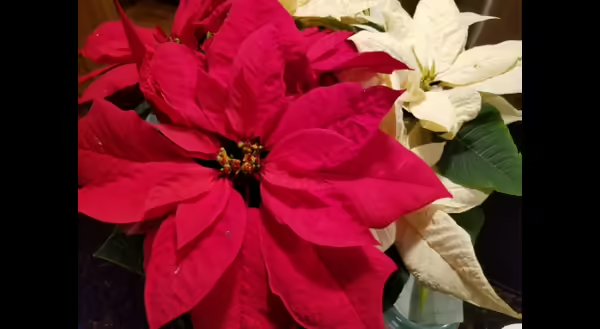
Poinsettias are a symbol of the holidays that have adorned wintertime homes in the US since their rise in popularity almost 200 years ago. These gorgeous plants are native to Mexico and naturally reach full bloom near the holidays, making them a ubiquitous plant of the holiday season. On average, they account for about one quarter of all potted plants sold in the US each year. With all this popularity, it is surprising to me that there are a number of misconceptions or myths surrounding this plant.
Most of us consider the most attractive part of a poinsettia to be its flower. However, it’s actually the plant’s leaves that hold its holiday beauty. The flower structure forms as a cluster of tiny yellow buds at the center of large showy-red bracts, or modified leaves. These showy leaves turn bright red in response to the plant forming flowers to provide the brilliant red color that contrasts with green foliage, creating their famous holiday beauty.
Poinsettias (Euphorbia pulcherrima) are native to tropical forests in Mexico and Central America. While we think of poinsettias as small potted plants, mature wild-grown plants across their natural range are much larger. In fact, the plant is considered a small tree in the wild, reaching heights of 12 feet or more.
Their brilliant red leaves are only one of the reasons they have attracted human attention over centuries. Use of the plant has been tracked back to as early as the 4th century where ancient Aztec cultures adored its beauty, but also used the bright red leaves as a dye and the milky sap for various medicinal purposes.
Across Mexico, poinsettias have been prized for their holiday beauty for centuries although it wasn’t until the 1800’s that they entered US culture. Joel Roberts Poinsett, the first US Ambassador to the newly recognized Republic of Mexico, was also a plant lover and an amateur botanist. In December of 1828, during a walk observing native flora, Poinsett noticed a beautiful flowering shrub along a Mexican roadside. He immediately collected cuttings to send home to the US for propagation in his South Carolina greenhouse. As the plant spread across the US it gained popularity, as well as the name Poinsettia, a nod to Mr. Poinsett. Click here for more information on Poinsett's role in poinsettia history.
Various warnings about the toxicity of poinsettias or their milky sap have taken many forms over the years. Some past warnings claim that gardeners have been poisoned while pruning and maintaining plants, presumably by exposure to the milky sap. Other claims note the plant as poisonous to humans, horses, and cattle, causing a myriad of symptoms after consumption.
Perhaps the most cited study to address this issue, was conducted by Ohio State researchers in the early 1970s. In this experiment, high doses of a mixture made from poinsettia leaves, bracts and flowers were given to rats. Of the 160 animals included in the study, none showed any symptoms of toxicity, changes in dietary intake, or behavior patterns. Subsequent studies since the 1970s report similar findings, with little evidence in literature of any serious repercussions from exposure to poinsettias.
A more recent study from the 1990s analyzed over 800,000 plant exposures reported to the American Association of Poison Control Centers between 1985 and 1992. Poinsettia exposure accounted for 22,793 of the cases, with no fatalities reported. Ninety-two percent of cases did not report any sign of toxicity related to poinsettia exposure with a large majority of cases (96%) never requiring any medical treatment. Skin irritation from exposures to poinsettia sap was the primary side effect reported in this study.
While poinsettias may not have serious toxic side effects, they certainly are not edible and their sap can be a skin irritant from many. In a worst case scenario there is potential for allergic reactions in some. However, the overwhelming evidence shows little risk in bringing home these holiday plants. Perhaps the best advice is to keep them away from pets and children, but the same can be said for most houseplants.
Interested in learning more about poinsettia care, history and lore? Check Illinois Extension’s website, The Poinsettia Pages.
References:
Stone R, Collins WJ. 1971. Euphorbia Pulcherrima: Toxicity to Rats. Toxicon 9: 301-302.
Krenzelok E, Jacobsen TD and Aronis J. 1996. Poinsettia Exposures Have Good Outcomes…. Just As We Thought. The American Journal of Emergency Medicine 14(7): 671-674.